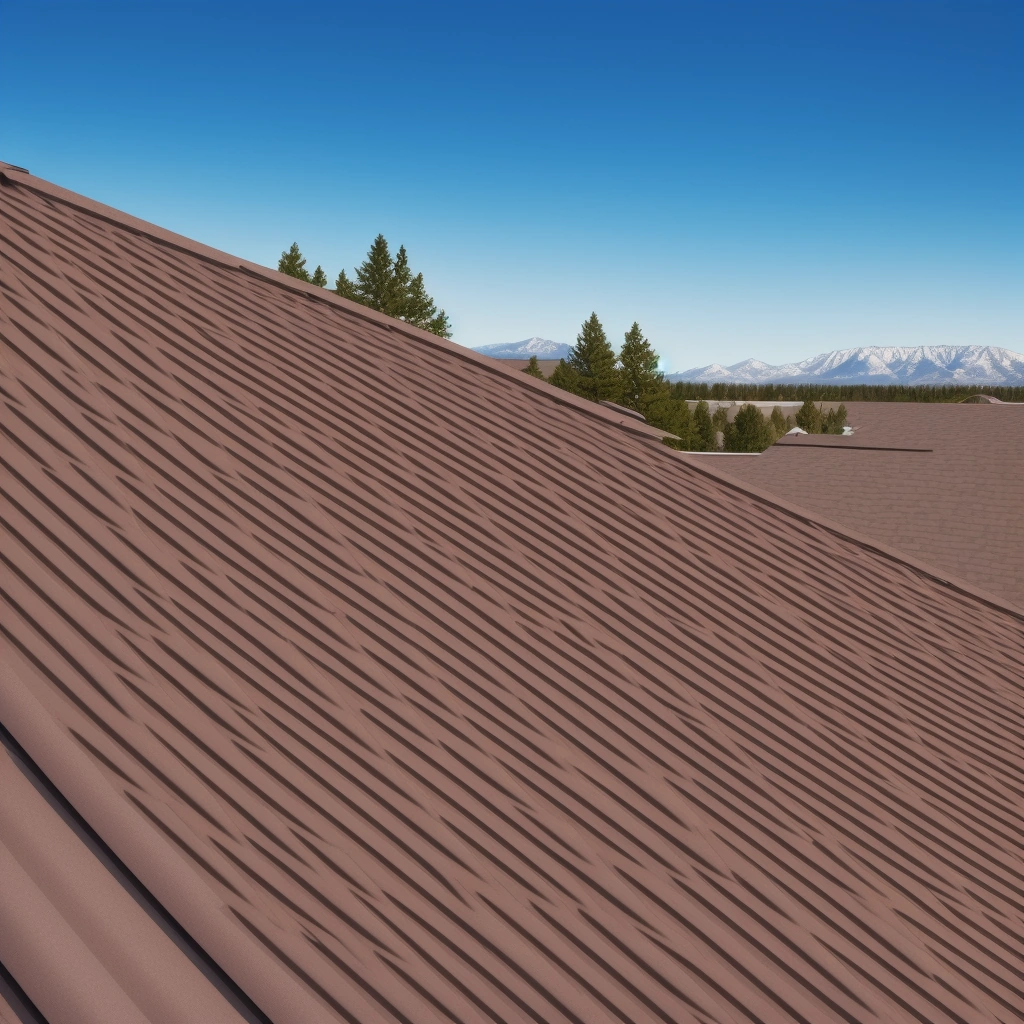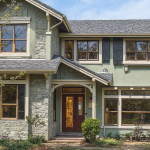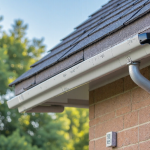Crafting the Perfect Roof: A Guide to Roofing Materials for Nevada’s Extreme Weather
Introduction: Roofing in the Nevada Desert
Nevada’s extreme climate, characterized by scorching summer temperatures often exceeding 110°F, high winds that can reach gale force, and occasional winter snowfall, presents significant challenges for homeowners, particularly when it comes to roofing. Choosing the right roofing material is not merely a matter of aesthetics; it’s a crucial decision impacting your home’s protection, energy efficiency, longevity, and overall value. This guide will navigate you through the best roofing options for Nevada’s demanding weather conditions, considering factors such as cost, durability, energy efficiency, and aesthetic appeal.
Understanding the interplay of these factors will empower you to make an informed decision that safeguards your investment for years to come. The intense solar radiation in Nevada makes energy efficiency a paramount concern. A poorly chosen roof can lead to significantly higher cooling costs, impacting your monthly budget and environmental footprint. “Homeowners in Nevada need to prioritize energy-efficient roofing materials,” advises John Smith, a leading roofing contractor in Las Vegas. “Selecting materials with high reflectivity and thermal resistance is key to minimizing heat absorption and reducing reliance on air conditioning.” Options like light-colored “cool roofs,” metal roofing with reflective coatings, and even solar tiles can significantly reduce energy consumption and contribute to a greener home.
These choices not only lower utility bills but also enhance the property’s value in the increasingly eco-conscious Nevada real estate market. Durability is another critical factor. High winds and temperature fluctuations can take a toll on roofing materials, leading to premature wear and tear. “Investing in durable, wind-resistant roofing is essential in Nevada,” says Jane Doe, a building inspector with extensive experience in the region. “Look for roofing materials with Class 4 impact ratings and strong wind uplift resistance to ensure your roof can withstand the elements.” Choosing robust materials like clay or concrete tiles, certain types of metal roofing, or even premium asphalt shingles with enhanced wind resistance can significantly extend the lifespan of your roof and minimize the need for costly repairs.
Furthermore, fire-resistant roofing materials are highly recommended, especially in areas prone to wildfires, offering an added layer of protection for your home and family. Beyond functionality, your roof significantly contributes to your home’s curb appeal, a vital factor in Nevada’s competitive real estate market. While asphalt shingles offer versatility in color and style, clay and concrete tiles provide a distinctive Southwestern aesthetic that resonates with the region’s architectural heritage. Metal roofing can offer a modern or rustic look, depending on the style and finish, while also providing exceptional durability and energy efficiency.
It’s essential to consider the architectural style of your home and your personal preferences when selecting a roofing material. Additionally, be sure to check with your Homeowners Association (HOA) for any regulations or restrictions that might influence your choice. Balancing aesthetic appeal with practical considerations ensures a roof that not only protects your home but also enhances its beauty and market value. Finally, understanding the total cost of ownership is crucial. While some roofing materials may have a lower initial cost, they might require more frequent maintenance or have a shorter lifespan, leading to higher expenses in the long run.
Factoring in the cost of installation, maintenance, and potential repairs will give you a clearer picture of the true cost of each roofing option. Consulting with reputable roofing contractors in Nevada is highly recommended to obtain accurate estimates and expert guidance tailored to your specific needs and budget. By carefully weighing these factors, you can make an informed decision and craft the perfect roof for your Nevada home, ensuring optimal protection, energy efficiency, and lasting value.
Roofing Material Options
“Asphalt Shingles: A Cost-Effective Choice for Nevada Homes”: Asphalt shingles remain a popular roofing choice in Nevada due to their affordability and relatively straightforward installation. Homeowners can choose from 3-tab, architectural, or luxury shingles, each offering a different aesthetic and level of durability. While the upfront cost is lower than other roofing materials, it’s essential to consider the lifespan, which typically ranges from 15 to 30 years in Nevada’s demanding climate. Regular maintenance and potential replacement costs should be factored into long-term budgeting.
For homeowners seeking budget-friendly roofing solutions, asphalt shingles provide a viable option, especially when professional installation by experienced Nevada roofing contractors ensures quality workmanship and maximizes lifespan. “Clay and Concrete Tiles: Durability and Distinctive Southwestern Style”: Clay and concrete tiles are renowned for their exceptional durability and resistance to fire, a crucial factor in Nevada’s arid landscape. These materials offer excellent protection against the intense sun, extreme temperature fluctuations, and occasional freeze-thaw cycles. While the initial investment is higher than asphalt shingles, the extended lifespan, often exceeding 50 years, makes them a cost-effective choice in the long run.
Homeowners appreciate the distinctive Southwestern aesthetic that clay and concrete tiles bring to Nevada real estate, enhancing curb appeal and property value. Proper installation and periodic maintenance are essential to ensure these durable roofing materials perform optimally throughout their lifespan. “Metal Roofing: Energy Efficiency and Longevity in Extreme Weather”: Metal roofing systems, including standing seam and corrugated metal, have gained significant popularity in Nevada for their exceptional performance in extreme weather conditions. Highly resistant to wind and fire, these roofs offer outstanding protection against Nevada’s harsh climate.
Their energy efficiency is another compelling advantage, as metal roofs reflect sunlight, reducing heat absorption and lowering cooling costs, a significant benefit for Nevada homeowners. With a lifespan of 50+ years, metal roofing represents a long-term investment that offers both durability and energy savings. Choosing energy-efficient roofing in Nevada contributes to green building practices and can increase a home’s value. “Solar Tiles: Integrating Renewable Energy into Your Roof”: Solar tiles seamlessly integrate solar technology directly into the roofing system, providing an aesthetically pleasing and environmentally friendly option for Nevada homeowners.
These tiles generate electricity while protecting the home, offering a dual-purpose solution that reduces energy bills and reliance on traditional power sources. With a lifespan comparable to traditional roofing materials, solar tiles represent a sustainable investment that aligns with green building principles. As energy costs continue to rise, solar tiles offer a proactive approach to reducing expenses and minimizing environmental impact, making them an increasingly attractive option for Nevada’s eco-conscious homeowners. “Choosing the Right Roofing for Your Nevada Home: Balancing Cost, Durability, and Aesthetics”: Selecting the best roofing material for a Nevada home requires careful consideration of various factors, including budget, desired lifespan, energy efficiency goals, and aesthetic preferences.
Asphalt shingles offer a cost-effective solution for budget-conscious homeowners, while tile and metal roofing provide enhanced durability and longevity. For those seeking environmentally friendly options, solar tiles offer a compelling solution. Consulting with experienced roofing contractors in Nevada is crucial to assess individual needs, evaluate site-specific conditions, and ensure proper installation. By carefully weighing these factors, homeowners can make informed decisions that enhance their home’s protection, energy efficiency, and curb appeal while aligning with Nevada’s unique climate and real estate landscape.
Energy Efficiency and Cost Considerations
Energy efficiency is not just a desirable feature in Nevada’s harsh climate; it’s a necessity that directly impacts both comfort and long-term costs for homeowners. The relentless Nevada sun can turn a poorly insulated roof into a significant source of heat gain, driving up air conditioning bills and placing undue stress on cooling systems. Opting for light-colored roofing materials, such as white or light gray tiles or shingles, is a strategic move to reflect solar radiation rather than absorb it.
This simple choice can significantly reduce the amount of heat transferred into the home, leading to lower energy consumption and a more comfortable indoor environment. In the context of Nevada real estate, homes with energy-efficient roofing are increasingly attractive to buyers who are mindful of long-term operational costs. Metal roofing stands out as a particularly energy-efficient option, especially when equipped with reflective coatings. These coatings, often made with specialized pigments, are designed to bounce back a substantial portion of the sun’s rays, minimizing heat absorption.
This can lead to significant savings on cooling costs during the scorching summer months. Furthermore, metal roofs are known for their durability and longevity, making them a smart investment for homeowners looking for a long-term solution. In addition to energy savings, durable roofing materials like metal are crucial in Nevada’s extreme weather conditions, offering superior protection against high winds and potential fire hazards, thereby enhancing the overall value and safety of the property. When considering roofing contractors Nevada, it’s essential to inquire about their experience with installing energy-efficient roofing systems.
Solar tiles represent another innovative approach to energy efficiency, integrating seamlessly with the roof’s design while generating clean, renewable energy. These tiles not only provide the benefits of a traditional roof but also contribute to reducing the home’s carbon footprint and reliance on the power grid. While the initial investment in solar tiles may be higher than other options, the long-term savings on electricity bills, coupled with potential government incentives and rebates, make them an increasingly attractive option for environmentally conscious homeowners.
For those interested in green building practices, solar tiles are a prime example of how roofing can contribute to a sustainable lifestyle and increase property value. When exploring roofing costs Nevada, it’s important to consider not just the initial price but also the long-term return on investment, particularly when it comes to energy savings. Beyond material choices, proper roof ventilation plays a critical role in maintaining energy efficiency. Adequate ventilation allows hot air trapped in the attic to escape, preventing it from radiating down into the living space.
This reduces the load on the air conditioning system and helps maintain a more consistent temperature throughout the home. This is especially important in Nevada’s desert climate where attic temperatures can reach extreme levels. Home maintenance should include regular inspections of the roof and ventilation system to ensure they are functioning optimally. Poor ventilation can lead to increased energy costs, premature wear on roofing materials, and potential moisture issues. When evaluating the best roofing for desert climate, homeowners must consider both the material and the overall system, including proper ventilation.
When selecting roofing materials Nevada, homeowners should also consider factors such as wind resistance and fire resistance. The strong winds common in Nevada can damage roofing materials, so choosing durable options that are designed to withstand these conditions is essential. Similarly, fire resistance is crucial in a region prone to wildfires. Materials like concrete and clay tiles offer superior fire resistance compared to some other options. Consulting with experienced roofing contractors Nevada can help homeowners navigate these considerations and choose a roofing system that meets their specific needs and budget. Ultimately, the right roofing choice will not only protect the home but also contribute to its energy efficiency, longevity, and overall value.
Aesthetics, HOA, and Maintenance
“Aesthetics play a crucial role in enhancing your home’s curb appeal, a significant factor in Nevada real estate. Choosing the right roofing material can significantly impact your home’s value and market appeal. Whether you’re aiming for a classic, modern, or Southwestern aesthetic, understanding the design implications of each roofing type is essential for maximizing your home improvement investment. Asphalt shingles offer a versatile palette of colors and styles, mimicking the look of wood shake or slate at a fraction of the cost.
This makes them a popular choice for homeowners seeking budget-friendly options without compromising curb appeal. For a distinctive Southwestern look, often favored in Nevada’s desert landscape, clay and concrete tiles are an excellent choice. Their earthy tones and textured profiles blend seamlessly with the natural surroundings, enhancing the architectural character of your home. Metal roofing, a growing trend in Nevada’s green building movement, provides a sleek and modern aesthetic, often seen in contemporary and minimalist designs.
Its diverse range of finishes, from bright and reflective to weathered and rustic, allows for customization to suit various architectural styles, making it a popular choice for both renovations and new constructions. Beyond aesthetics, the choice of roofing material significantly influences your home maintenance routine. Asphalt shingles, while cost-effective, require more frequent inspections and potential repairs compared to more durable options like tile or metal. Clay and concrete tiles, known for their longevity and resistance to extreme weather, offer low maintenance requirements, ultimately saving homeowners time and money in the long run.
Metal roofing also boasts minimal maintenance needs, adding to its appeal for those seeking a hassle-free home improvement solution. However, periodic cleaning is recommended to maintain optimal performance and aesthetics. Before finalizing your roofing decision, it’s crucial to consider the regulations set by your Homeowners Association (HOA), if applicable. HOA guidelines often dictate permissible roofing materials, colors, and styles to maintain a cohesive community aesthetic. Ignoring these regulations can lead to costly rework and disputes, making it essential to consult your HOA guidelines early in the planning process.
This proactive approach ensures your roofing project aligns with community standards while enhancing your home’s value and visual appeal. In Nevada’s extreme weather conditions, choosing durable roofing materials is paramount for protecting your investment and ensuring long-term performance. Wind-resistant shingles, impact-resistant tiles, and robust metal roofing systems are designed to withstand the harsh desert climate, including strong winds, intense sunlight, and occasional hailstorms. Investing in high-quality, durable roofing not only safeguards your home but also minimizes the need for frequent repairs and replacements, contributing to long-term cost savings.
Roofing contractors in Nevada can provide expert guidance on selecting the best roofing materials for your specific needs and budget, considering factors such as energy efficiency, durability, and HOA requirements. Obtaining multiple quotes from reputable roofing contractors allows for informed decision-making, ensuring you receive competitive pricing and quality workmanship. Roofing costs in Nevada vary depending on the chosen material, the complexity of the project, and the prevailing market rates. It’s essential to factor in both material and labor costs when budgeting for your roofing project, ensuring a realistic and comprehensive financial plan.”
Conclusion: Making the Right Choice
Choosing the right roofing material for a Nevada home is a multifaceted decision, demanding a careful balance between cost, durability, energy efficiency, and aesthetic appeal. For homeowners prioritizing budget, asphalt shingles remain a popular and viable option, offering a range of styles and colors at a relatively lower initial cost. However, in Nevada’s extreme weather, including intense sun and occasional high winds, the lifespan of asphalt shingles may be shorter compared to other materials, making it crucial to consider long-term replacement costs.
When evaluating ‘Roofing Costs Nevada’, remember to factor in not just the initial installation but also maintenance and potential replacement expenses over the life of the roof. Homeowners should seek quotes from multiple ‘Roofing Contractors Nevada’ to ensure competitive pricing and quality workmanship. For those seeking enhanced longevity and energy savings, metal roofing and clay or concrete tiles present compelling alternatives. Metal roofing, known for its durability and reflective properties, is an excellent choice for mitigating the intense Nevada heat, contributing to lower cooling costs and making it a prime example of ‘Energy Efficient Roofing Nevada’.
Metal roofs can last for 50 years or more, and their wind resistance makes them a solid choice in areas prone to gusts. Clay and concrete tiles, while generally more expensive upfront, offer exceptional fire resistance and a classic aesthetic that complements many Southwestern-style homes. These options, often considered ‘Durable Roofing’ choices, provide significant long-term value, minimizing the need for frequent replacements. When considering ‘Best Roofing for Desert Climate’, these materials often emerge as top contenders due to their resilience and performance.
Solar tiles represent an investment in both energy efficiency and environmental responsibility. Integrating solar technology directly into the roofing material, these tiles generate clean energy, reducing reliance on the electrical grid and lowering utility bills. While the initial investment for solar tiles is higher, the long-term savings and environmental benefits make them an attractive option for homeowners focused on ‘Green Building’ practices. Furthermore, the increasing availability of government incentives and rebates for solar installations can help offset the upfront costs, making them a more accessible option for many.
Choosing ‘Roofing Materials Nevada’ that aligns with sustainable practices is not only beneficial for the environment but also adds value to the property. Considering the specific challenges of ‘Extreme Weather Roofing’ in Nevada, wind resistance is a critical factor. Both metal roofing and tile roofs are known for their ability to withstand high winds, offering superior protection compared to asphalt shingles. Similarly, fire resistance is a significant concern in dry climates, making clay, concrete, and metal options particularly appealing.
When evaluating ‘Wind Resistant Roofing’ and ‘Fire Resistant Roofing’, it’s essential to choose materials that have been tested and certified to meet local building codes. Homeowners should consult with qualified roofing professionals who have experience working with these materials in the Nevada climate. Proper installation is just as important as the material itself to ensure optimal performance and longevity. Ultimately, selecting the appropriate roofing material is a highly individualized decision that should be based on your specific needs, budget, and aesthetic preferences. Thorough research and consultation with reputable ‘Roofing Contractors Nevada’ are essential to making an informed choice that will protect your home for years to come. Consider not only the initial costs but also the long-term benefits in terms of durability, energy efficiency, and potential property value. By carefully weighing these factors, homeowners can ensure they are making an investment that will safeguard their homes and enhance their quality of life.


